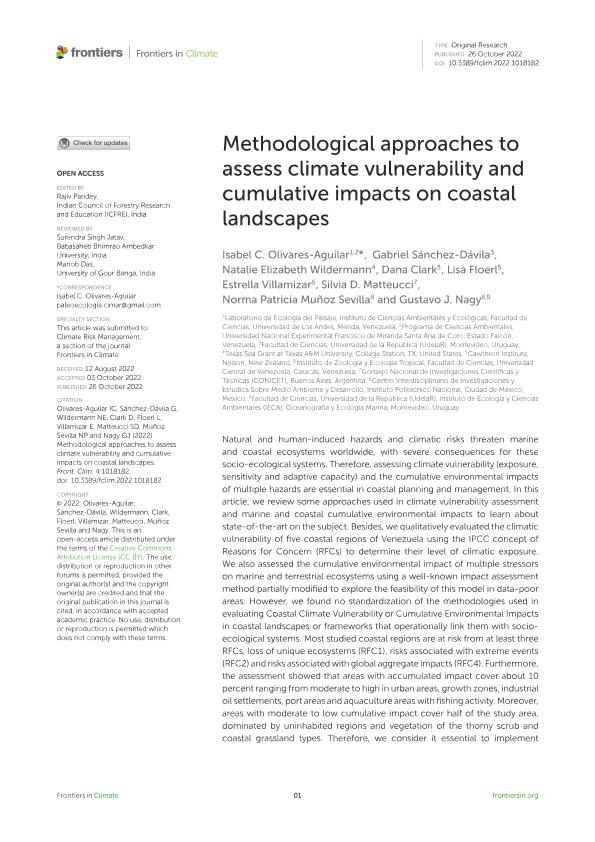Mostrar el registro sencillo del ítem
dc.contributor.author
Abad Villamor, Ana Isabel

dc.contributor.author
Sánchez Dávila, Gabriel
dc.contributor.author
Wildermann, Natalie Elizabeth
dc.contributor.author
Clark, Dana
dc.contributor.author
Floerl, Lisa
dc.contributor.author
Villamizar, Estrella
dc.contributor.author
Matteucci, Silvia Diana

dc.contributor.author
Muñoz Sevilla, Norma Patricia
dc.contributor.author
Nagy, Gustavo J.
dc.date.available
2023-11-15T16:06:18Z
dc.date.issued
2022-10
dc.identifier.citation
Abad Villamor, Ana Isabel; Sánchez Dávila, Gabriel; Wildermann, Natalie Elizabeth; Clark, Dana; Floerl, Lisa; et al.; Methodological approaches to assess climate vulnerability and cumulative impacts on coastal landscapes; Frontiers Media; Frontiers in Climate; 4; 10-2022; 1-19
dc.identifier.issn
2624-9553
dc.identifier.uri
http://hdl.handle.net/11336/218217
dc.description.abstract
Natural and human-induced hazards and climatic risks threaten marine and coastal ecosystems worldwide, with severe consequences for these socio-ecological systems. Therefore, assessing climate vulnerability (exposure, sensitivity and adaptive capacity) and the cumulative environmental impacts of multiple hazards are essential in coastal planning and management. In this article, we review some approaches used in climate vulnerability assessment and marine and coastal cumulative environmental impacts to learn about state-of-the-art on the subject. Besides, we qualitatively evaluated the climatic vulnerability of five coastal regions of Venezuela using the IPCC concept of Reasons for Concern (RFCs) to determine their level of climatic exposure. We also assessed the cumulative environmental impact of multiple stressors on marine and terrestrial ecosystems using a well-known impact assessment method partially modified to explore the feasibility of this model in data-poor areas. However, we found no standardization of the methodologies used in evaluating Coastal Climate Vulnerability or Cumulative Environmental Impacts in coastal landscapes or frameworks that operationally link them with socio-ecological systems. Most studied coastal regions are at risk from at least three RFCs, loss of unique ecosystems (RFC1), risks associated with extreme events (RFC2) and risks associated with global aggregate impacts (RFC4). Furthermore, the assessment showed that areas with accumulated impact cover about 10 percent ranging from moderate to high in urban areas, growth zones, industrial oil settlements, port areas and aquaculture areas with fishing activity. Moreover, areas with moderate to low cumulative impact cover half of the study area, dominated by uninhabited regions and vegetation of the thorny scrub and coastal grassland types. Therefore, we consider it essential to implement regional climate risk management that incorporates these assessments into the ordinance in countries that are particularly vulnerable to climate change, such as Venezuela, which has an extensive line of low-lying coastlines (where 60% of the country's population lives) and coastal regions with harsh climates and poor economic conditions. Finally, we present the scope and limitations of implementing these evaluations and highlight the importance of incorporating them into regional strategies for adaptation to climate change.
dc.format
application/pdf
dc.language.iso
eng
dc.publisher
Frontiers Media

dc.rights
info:eu-repo/semantics/openAccess
dc.rights.uri
https://creativecommons.org/licenses/by-nc-sa/2.5/ar/
dc.subject
ADAPTATION
dc.subject
CLIMATE RISKS
dc.subject
COASTAL ECOSYSTEMS
dc.subject
ENVIRONMENTAL IMPACT
dc.subject
MARINE ECOSYSTEMS
dc.subject
SOCIO-ECOLOGICAL SYSTEMS
dc.subject
THREATS
dc.subject.classification
Otras Ciencias de la Tierra y relacionadas con el Medio Ambiente

dc.subject.classification
Ciencias de la Tierra y relacionadas con el Medio Ambiente

dc.subject.classification
CIENCIAS NATURALES Y EXACTAS

dc.title
Methodological approaches to assess climate vulnerability and cumulative impacts on coastal landscapes
dc.type
info:eu-repo/semantics/article
dc.type
info:ar-repo/semantics/artículo
dc.type
info:eu-repo/semantics/publishedVersion
dc.date.updated
2023-11-14T14:23:19Z
dc.journal.volume
4
dc.journal.pagination
1-19
dc.journal.pais
India

dc.journal.ciudad
Manob Das
dc.description.fil
Fil: Abad Villamor, Ana Isabel. Universidad de los Andes; Colombia
dc.description.fil
Fil: Sánchez Dávila, Gabriel. Universidad de la Republica; Uruguay
dc.description.fil
Fil: Wildermann, Natalie Elizabeth. Texas A&M University; Estados Unidos
dc.description.fil
Fil: Clark, Dana. No especifíca;
dc.description.fil
Fil: Floerl, Lisa. No especifíca;
dc.description.fil
Fil: Villamizar, Estrella. Universidad Central de Venezuela; Venezuela
dc.description.fil
Fil: Matteucci, Silvia Diana. Consejo Nacional de Investigaciones Científicas y Técnicas; Argentina
dc.description.fil
Fil: Muñoz Sevilla, Norma Patricia. ;
dc.description.fil
Fil: Nagy, Gustavo J.. Universidad de la Republica; Uruguay
dc.journal.title
Frontiers in Climate
dc.relation.alternativeid
info:eu-repo/semantics/altIdentifier/doi/http://dx.doi.org/10.3389/fclim.2022.1018182
Archivos asociados
